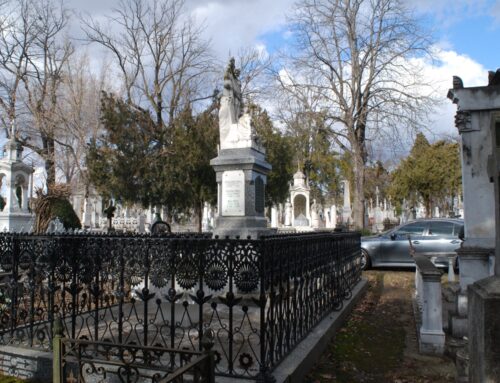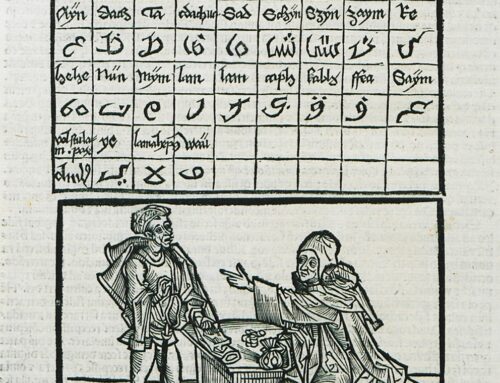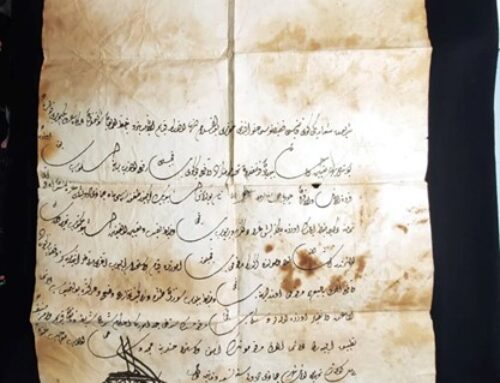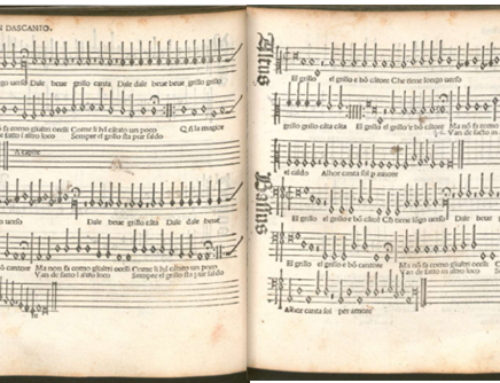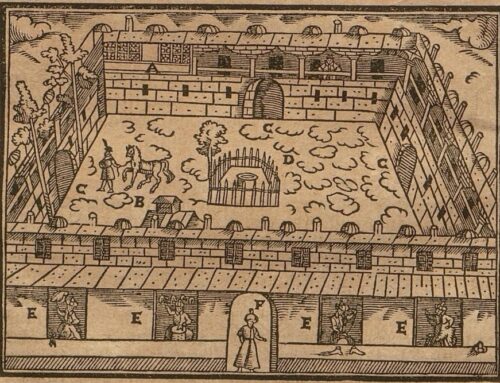The heading of Riccardiana MS 2523 proclaims its nature as a record of prices and tariffs for merchants and goods trading with Damasco and the rest of Siria. This manuscript was one of the items on display in a recent exhibition organized by our PIMo COST Action at the Biblioteca Riccardiana in Florence (“Encounters at Sea: People, Paper, and Objects in Motion at the Riccardiana Library”). Dated on November 25th 1534, the tariffa was put together under the supervision of patricians who belonged to some of the most prominent Venetian families.
Tarriffa | di tutto quello si deue | mettere a conto alli ma[rca]| danti, et marcantie, si[a] | in Damasco, come in tutta | la Soria R[i]formata p[er] | il Clmo M. Piero Molino, | cons. Insieme con li Magci | M. Antonio Grimani fu |del magco. ms. Nico. Ms. Nico| Venier fu del mco.Ms. Ago≈|stino, et ms Vicenzo Mo≈|resini del Magco. M. Barbon | deputati, & eletti per | Conseglio, come per parte | presa appar sotto li.25.| di Nouembre.|M D XXX IIII
One of them is Piero da Molin, who is mentioned in his capacity as a consul, i.e. a diplomatic agent in charge of mercantile affairs who had negotiated some of these tariffs with the Muslim authorities in the Levant (“Stime nove fatte per il Sigor Alibey con il magco Consolo m Piero da Molino dell’Anno di 1534”, fol. 47v). The other Venetian grandee whose name appears as one of those responsible for the compilation of these tables is Marco Antonio Grimani. In the 1530s Grimani was one among i venti savi super taxis, and in 1530 and 1536 he also acted as savio alla mercanzia. The committee of five savi alla mercanzia regulated arts and crafts, navigation, cross-border trade and its tariffs. Its numerous attributions also gave it control over maritime insurance, contraband, foreign communities and their diplomats, as well as Venetian consuls abroad. This tariffa was, in short, negotiated, drafted and enforced by the Venetian establishment for its deals with the Levant in the early years of the sixteenth century. As such, it is proof of the sophisticated administrative structures that Venice had developed to regulate and run the exchange of goods, the movement of people, and the circulation of value—financial and otherwise. This control required an equally complex and sophisticated system for the recording of information and its systematic processing so that the same standards could be applied over different products, locations, and practices. They also required negotiation with foreign authorities and merchants with a view to the establishment of treatises and standard methods for cross-cultural and cross-linguistic trade.
The Oxford English Dictionary traces the etymology of the English noun tariff back to the Arabic ta῾rīfa, which it describes as “notification, explanation, definition, article”, i.e. a recorded piece of information. From Arabic, this noun passed on to Italian first in the late Middle Ages, and then to English late in the sixteenth century. The first recorded uses of this noun are dated around 1591-1592, and one of the samples quoted by the OED is precisely a letter by Sir Henry Wotton, the notorious English traveller and diplomat, who in 1592 wrote from Florence to his correspondent, Lord Douche, informing him that “the book that I put to be copied for your Honour is not yet ended, nor the tariffa of all the towns in the Grand Duke’s territories, in my hands”.[1] A few years later, John Florio’s Italian-English dictionary (Queen Anna’s World of Words, 1611, p. 553), defined tariffa as “arithmetike, casting of accompts”. Like paper, and like numerals, like other terms used in mathematics and algebra, the Italian noun tariffa arrived in the Mediterranean world via Muslim administrators, scholars, travellers and merchants.
The history of paper in the Muslim world, and its connections with mathematics, astronomy, administrative and accounting methods was outlined by Jonathan Bloom in his Paper Before Print: The History and Impact of Paper in the Islamic World (Yale University Press, 2001). This is a story that combines the material and semiotic aspects of paper, ideas, people and objects in motion. It also involves the important phenomenon of communication and the circulation of information during the pre-modern and the early modern Mediterranean world. Arriving with paper, and boiled down to its core meaning, the term tariffa denotes information recorded in a table, or a list with items usually coupled with figures and a variety of symbolic systems for classification, quantification, and calculation. In other words, a systematic record of information with a view to its efficient communication and practical application.
Our tariffa constitutes a case study for this kind of documentary genre, which was used as an instrument for the regulation of trade and as a tool for the calculation of the costs involved in its practice. It also amounts to a catalogue of the material products that were traded between Venice and the Levant during the early decades of the sixteenth century. And by registering and quantifying expenses incurred by translations and translators, it also incorporates the cost involved in the practice of cross-cultural and cross-linguistic exchange of information—a sine qua non for international trade. It incorporates, in other words, data regarding the material foundations of trade (goods, their prices, their weights and measures) alongside its inescapable immaterial dimension, by quantifying and listing expenses in translation (turcimanarie) and translators. Turcimanni (i.e. translators, or interpreters, from Old Arabic targumān) were the cultural and linguistic mediators whose intervention was fundamental for the establishment of trade and diplomatic relations—two practices that complemented each other, as demonstrated by the inclusion of the consul Piero da Molino as one of the supervisors of the tariffa and the negotiators of its terms. Turcimanni established linguistic and cultural equivalence, as much as some of the tables included in the manuscript facilitated the equivalence of different exchange rates, or different weights and measures (“Come rispondono tutti le pesi di Soria, et altri lochi con Venetia”. Fol. 61v; “Tariffa di Turcimanarie”, fol. 65r).
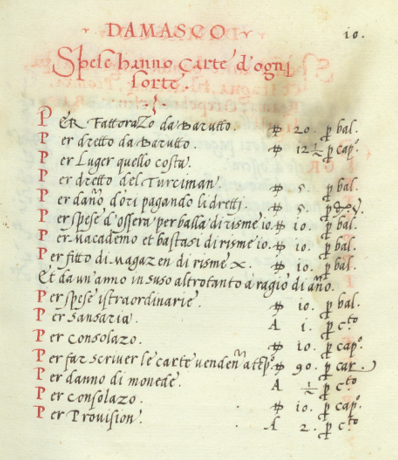
Tariffe mercantili del Levante. 16th-c. Ms, fol. 10r. ‘Damasco Spese: hanno Carte d’ogni sorte’
(Biblioteca Riccardiana 2523, with permission)
Significantly, our tariffa also lists and quantifies important aspects of paper trade, the actual material medium employed for the registration and communication of information (fol. 10r). Like innovative mathematical methods for quantification and measurement in a large variety of activities, from astronomy to trade, paper arrived in the Mediterranean around the 12th-13th centuries thanks to Muslim expansion and trade. By the time our tariffa was put together, however, European paper-mills had perfected its elaboration and turned it into one of the products that were exported to those places in the Muslim world, like the Levant, where it had been manufactured in the first place, and from whence it had been imported to the South of Europe around three hundred years before. The forthcoming workshops organized by the Paper in Motion Work Group of the PIMo COST Action will address some of these material and immaterial aspects of paper, and its close relation with people, ideas, and objects in motion.
José María Pérez Fernández is professor of English Literature at the University of Granada. He has published on topics which approach the intersection of comparative literature, cultural, and translation studies with subjects that include the international republic of letters and the early modern idea of Europe, as well as practices like diplomacy and the book trade. He is particularly interested in processes of communication in the early modern world—the paper revolution, the impact of print, and how financial and mercantile processes mirrored the ways in which information and knowledge exchange took place. homeluna In 2019 he joined the People in Motion COST Action as the leader of a work group on “Paper in Motion”. His book on Hernando Colón’s library (with E. Wilson-Lee) will be published by Yale in 2021. He has just joined the project for a critical edition of one of Hernando Colón’s most important catalogs, the so-called Libro de los Epítomes.
[1] “H. Wotton Let. to Ld. Zouche 3 Oct. in L. P. Smith Life & Lett. Sir H. Wotton (1907) I. 288 The book that I put to be copied for your Honour is not yet ended, nor the tariffa of all the towns in the Grand Duke’s territories, in my hands.” (“tariff, n.” OED Online. Oxford University Press, March 2020. Web. 3 May 2020). See also https://archive.org/details/lifelettersofsir01smitiala/page/288/mode/2up


